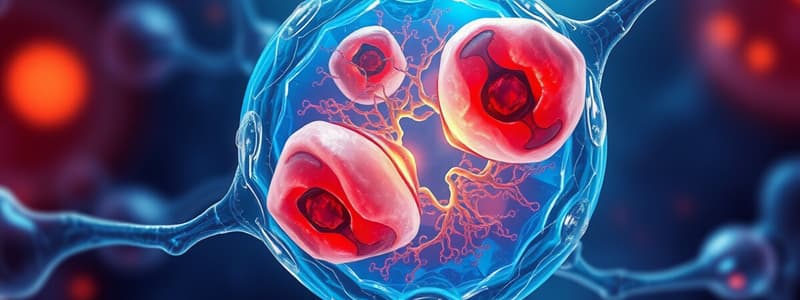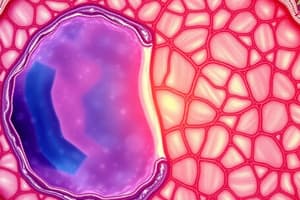Podcast
Questions and Answers
What occurs during anaphase in cell division?
What occurs during anaphase in cell division?
- Cleavage furrow formation starts
- Sister chromatids pull apart toward centromeres (correct)
- Chromosomes line up along the equator
- Nuclear envelope reformation begins
Which phase of cell division involves the breakdown of spindles and reversion to an unconsolidated state?
Which phase of cell division involves the breakdown of spindles and reversion to an unconsolidated state?
- Telophase (correct)
- Anaphase
- Prophase
- Metaphase
How can interphase be differentiated from prophase?
How can interphase be differentiated from prophase?
- By chromosome alignment
- By cell size increase
- By the nuclear envelope (correct)
- By the presence of active spindles
What is NOT a function of epithelial tissue?
What is NOT a function of epithelial tissue?
Where can epithelial tissues commonly be found?
Where can epithelial tissues commonly be found?
Which of the following is NOT one of the characteristics of epithelial tissue?
Which of the following is NOT one of the characteristics of epithelial tissue?
What are the two poles of epithelial tissue?
What are the two poles of epithelial tissue?
What structures are the pancreas glands made up of?
What structures are the pancreas glands made up of?
What are the four main functions of connective tissue?
What are the four main functions of connective tissue?
Which of the following correctly identifies the three types of protein fibers found in connective tissue?
Which of the following correctly identifies the three types of protein fibers found in connective tissue?
Identify the three types of connective tissue.
Identify the three types of connective tissue.
What is the primary function of fibroblast cells in connective tissues?
What is the primary function of fibroblast cells in connective tissues?
Which immune cell type is responsible for defense and uses phagocytosis?
Which immune cell type is responsible for defense and uses phagocytosis?
What characteristic defines areolar connective tissue?
What characteristic defines areolar connective tissue?
What role do adipocytes primarily serve in connective tissues?
What role do adipocytes primarily serve in connective tissues?
Which type of connective tissue contains both immune cells and fibroblasts?
Which type of connective tissue contains both immune cells and fibroblasts?
Which of the following glands is classified as a multicellular exocrine gland?
Which of the following glands is classified as a multicellular exocrine gland?
What type of exocrine secretion is characterized by the product accumulating in the apical portion of the cell cytoplasm before being decapitated?
What type of exocrine secretion is characterized by the product accumulating in the apical portion of the cell cytoplasm before being decapitated?
Which secretion method results in no damage to the cell during the release process?
Which secretion method results in no damage to the cell during the release process?
What distinguishes serous fluid in composition compared to mucous fluid?
What distinguishes serous fluid in composition compared to mucous fluid?
Which type of gland is characterized as being unicellular and located close to the surface?
Which type of gland is characterized as being unicellular and located close to the surface?
Which of the following is NOT a type of exocrine secretion method?
Which of the following is NOT a type of exocrine secretion method?
What is the main characteristic of holocrine secretion?
What is the main characteristic of holocrine secretion?
Which of the following combinations is correct regarding the types of secretions?
Which of the following combinations is correct regarding the types of secretions?
Which type of connective tissue provides insulation for the body and stores energy?
Which type of connective tissue provides insulation for the body and stores energy?
What type of fibers does areolar connective tissue contain?
What type of fibers does areolar connective tissue contain?
Which of the following is NOT a type of dense connective tissue?
Which of the following is NOT a type of dense connective tissue?
What is a primary function of dense regular connective tissue?
What is a primary function of dense regular connective tissue?
What type of cells are found in both dense regular and dense irregular connective tissue?
What type of cells are found in both dense regular and dense irregular connective tissue?
Reticular connective tissue is primarily associated with which of the following functions?
Reticular connective tissue is primarily associated with which of the following functions?
Which connective tissue type is characterized by very little extracellular matrix and a bublike structure?
Which connective tissue type is characterized by very little extracellular matrix and a bublike structure?
Which types of loose connective tissue are identified?
Which types of loose connective tissue are identified?
What is the primary function of dense irregular connective tissue?
What is the primary function of dense irregular connective tissue?
Where is elastic connective tissue predominantly located?
Where is elastic connective tissue predominantly located?
Which of the following correctly describes a characteristic of elastic connective tissue?
Which of the following correctly describes a characteristic of elastic connective tissue?
What type of protein fibers primarily compose elastic connective tissue?
What type of protein fibers primarily compose elastic connective tissue?
Which of the following locations is NOT typically associated with dense irregular connective tissue?
Which of the following locations is NOT typically associated with dense irregular connective tissue?
Study Notes
Cell Division and Epithelial Tissue
- Anaphase: Sister chromatids separate and move toward opposite centrosomes.
- Telophase:
- Chromosomes revert to an uncondensed state as spindle fibers break apart.
- Cleavage furrow formation occurs at the equator.
Interphase Characteristics
- Interphase is distinguished from Prophase by the presence of a nuclear envelope.
Epithelial Tissue Overview
- Epithelial tissue covers and lines organs and body cavities.
- Functions of epithelial tissue include:
- Protection against external factors.
- Permeability regulation allowing substance passage.
- Sensation through nerve endings.
- Secretion of various substances.
Epithelial Locations and Types
- Found on body surfaces, lining cavities, and tubular structures.
- The pancreas consists of glands made of epithelium.
Epithelial Tissue Characteristics
- Characteristics include:
- High cellularity with minimal extracellular matrix (ECM).
- Polarity with distinct apical and basal layers.
- Attachment to the basement membrane.
- Avascularity, lacking blood vessels.
- High regeneration capacity.
Poles of Epithelial Tissue
- Apical Pole: Free surface exposed to the external environment.
- Basal Pole: Attached to the underlying basement membrane.
Exocrine Glands
- Multicellular Exocrine Glands: Include pancreas, mammary glands, and salivary glands.
- Unicellular Exocrine Glands: Mucous and goblet cells, located close to epithelial surfaces.
Exocrine Secretion Types
- Two main types of exocrine secretions:
- Serous: Thin, watery fluids (e.g., sweat, milk, tears) with a dark stain.
- Mucous: Thick fluids consisting of mucin and water, stained light.
Secretory Methods
- Three Types:
- Merocrine: Secretion occurs via exocytosis without damaging cells.
- Holocrine: Cells rupture releasing the product, damaging the cells.
- Apocrine: Product accumulates in the apical portion, leading to cell decapitation.
Functions and Components of Connective Tissue
- Functions include:
- Protection of organs.
- Structural support.
- Binding tissues.
- Storage of energy.
- Transportation of materials.
- Immune defense.
- Components consist of cells, protein fibers, and ground substance.
Protein Fibers in Connective Tissue
- Types of protein fibers include collagen, elastic, and reticular fibers.
- Connective tissue types categorized as fibrous, supportive, and fluid.
Key Cell Types in Connective Tissue
- Fibroblasts: Most common cells, synthesize fibers and ground substance.
- Adipocytes: Specialized in fat storage.
- Mesenchymal Cells: Embryonic stem cells involved in healing.
- Immune Cells: Include macrophages, mast cells, and leukocytes.
Areolar Connective Tissue
- Loose, diverse structure with a watery ECM.
- Functions include cushioning organs, phagocytosis of bacteria, roles in inflammation, and fluid management.
Types of Connective Tissue
- Loose Connective Tissue: Includes areolar, adipose, and reticular.
- Dense Connective Tissue: Comprises dense regular, dense irregular, and elastic.
Dense Regular and Irregular Connective Tissue
- Dense Regular:
- Structure: Tight, dense arrangement for limited stretch in one direction.
- Location: Tendons, ligaments, and fascia.
- Dense Irregular:
- Structure: Irregular arrangement, withstands tension in multiple directions.
- Location: Fibrous capsules of organs, dermis, and submucosa of the digestive tract.
Elastic Connective Tissue
- Function: Facilitates recoil following stretching; maintains blood flow; assists lung function post-inspiration.
- Location: Present in large arteries, ligaments of the vertebral column, and bronchial tubes.
Protein Fiber in Elastic Connective Tissue
- Composed primarily of elastic fibers.
Studying That Suits You
Use AI to generate personalized quizzes and flashcards to suit your learning preferences.
Related Documents
Description
Test your knowledge on the processes of cell division, specifically anaphase and telophase, as well as the characteristics and functions of epithelial tissue. This quiz covers the general features of interphase and various types of epithelial tissues in the body.




